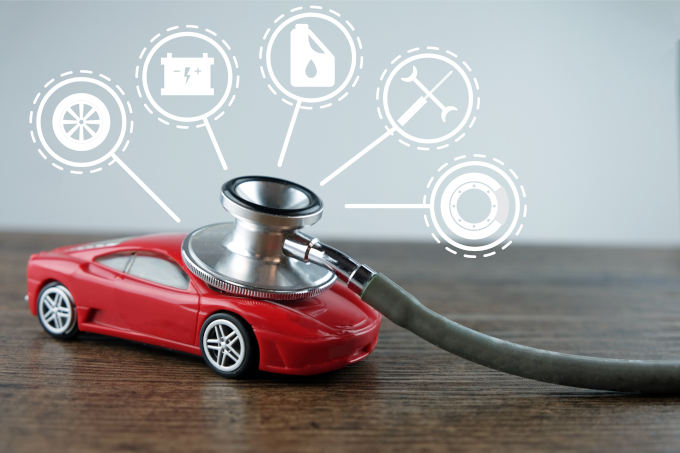Can you guess how long the longest-lasting vehicle has been on the road? One million miles? Two million miles? You may be shocked to learn that the world record for the most miles on a vehicle is a 1966 Volvo 1800 with over 4 million miles by its original owner Irvin Gordon.
The fact is, many vehicles are capable of lasting several hundred thousand miles with the proper maintenance.
At the critical 100,000-miles mark, there are certain services that you should perform on your vehicle if you want it to last. Here, we'll take a look at what should be serviced at the 100,000-mile tune-up and how to make your vehicle last long afterward. While this article gives helpful tips about proper vehicle care, always consult your owner’s manual for the manufacturer's recommended maintenance schedule for your specific vehicle.
Why a 100,000-mile tune-up is important
Typically, the 100,000-mile mark is when significant problems arise within the vehicle, including transmission failure, timing belt failure, water pump breaks, and damage from corrosion.
What is serviced at the 100,000-miles?
At the 100,000-mile maintenance check, a service center will perform major and routine services on a vehicle. Here's a look at some of the most common components checked and replaced:
Timing belt
The timing belt's function is to synchronize the crankshaft and camshaft rotation to ensure your engine works correctly. The camshaft operates the valves in your engine to let air in and out. The crankshaft moves the pistons up and down. If these components are not working in unison, damage to the engine can occur, along with costly repairs.
Timing belts are made out of rubber and fiber and will inevitably wear down over time. The timing belt must be replaced at the manufacturer's recommended interval to reduce the risk of a broken timing belt. A broken timing belt can result in extensive and expensive engine damage or even catastrophic failure. Replacement of this component is likely at your 100,000-mile maintenance check.
Water pump
The water pump's job is to keep coolant moving through your vehicle's engine block, radiator, and hoses to help maintain a proper operating temperature.
Commonly, your timing belt usually drives the water pump. Your water pump may also be replaced at the same time as your timing belt because it's easier and cheaper to do so. Water pumps are designed to last about 100,000 miles, so it's a good time for a new one regardless. Invest in a high-quality replacement unit to ensure it lasts another 100,000 miles along with your timing belt. Cheaper water pumps could fail as early as 30,000 miles.
Fluids
Your vehicle's fluids play an essential role in your vehicle's health and performance. These fluids include engine oil, brake fluid, transmission fluid, and coolant. Each fluid should be inspected during your 100,000-mile maintenance check to determine its condition and level.
Brakes
The brake pads are checked and changed if needed. The brake lines may be checked to ensure that they are all in working order. If your vehicle has brake rotors, then the rotors may need to be turned if worn.
Tires
Your vehicle's tires will be thoroughly inspected at this maintenance appointment. Tire pressure and tread depth will be checked. Any signs of uneven wear, cracking, or bulging will likely require replacement or rotation.
Spark plugs
Your engine's spark plugs are what start your vehicle. Their condition and quality can maximize your vehicle's driveability and fuel economy. Spark plugs are often replaced during your 100,000-mile tune-up. Choosing ones of higher quality materials, such as platinum or iridium, can be beneficial regarding longevity.
Exhaust system
The exhaust system is checked for leaks, holes, and cracks to ensure emissions properly move from the engine to the muffler. The accumulation of build-up inside the exhaust system is typical over time, narrowing various passageways and putting stress on the system, which can greatly lower fuel efficiency. This is an excellent time to have the exhaust system thoroughly cleaned.
The catalytic converter, a component of your exhaust system that converts toxic exhaust pollutants into less harmful pollutants (such as converting carbon monoxide into carbon dioxide), is usually designed to last about 100,000 miles and may need to be replaced.
Oxygen sensors are another part of your vehicle's exhaust system and measure the amount of unburned oxygen in emission gasses. Its primary function is to make sure your vehicle has the correct air-to-fuel ratio for maximum efficiency. These sensors may also need replacement at your 100,000-mile maintenance check.
Maintaining Your Vehicle After 100,000 Miles
After the 100,000-mile maintenance check, it is vital to perform routine maintenance on your vehicle to ensure the best performance and long life. Here are some regular maintenance tips that you should keep on top of from this point on:
Routine Service Checks
Having your vehicle serviced regularly is critical in reducing costly car repairs and ensuring reliable health and performance over the long term.
Don't Ignore Brewing Trouble
According to AAA research, one-third of vehicle owners go into debt due to unexpected vehicle repairs. It's easy to skip routine maintenance or ignore small sounds and sensations with an aging car, but these seemingly minor problems can quickly turn into serious and expensive ones. Knowing the warning signs of things like transmission or brake failure can save you a bundle in repairs costs.
Items You Can Check Yourself
You can check some components of your vehicle without the help of a trained technician.
Tires
There are two main areas of tire maintenance you can do yourself, and they are both free and require no expertise.
- Keep your tire pressure at the recommended PSI level
Your tires perform best, last their longest, and are safest when at the PSI (pressure-per-square-ich) that is specific to the make and model of your vehicle. If you're not sure what that is, check with your owner's manual or look it up online. Also, PSI is affected by temperature, which could make your tires either underinflated or overinflated. Underinflated tires can lead to less control on the road, especially in wet, slippery conditions. Conversely, overinflated tires, especially in hotter weather, can lead to blowouts. If you have a broad fluctuation in temperature and weather conditions throughout the year, it's a good idea to check the air pressure at least once a month or if there is a sudden change in temperature of ten degrees or more.
- Inspect tires for tread wear
You will want to ensure that the vehicle's tires have enough tread for proper traction and control. A simple way to quickly check a tire's tread levels is by conducting the Penny Test — placing a penny in the tire's ridges, ensuring that you cannot see the top of Honest Abe's head. However, the more accurate Quarter Test is now recommended instead for increased safety.
Fluids
Some fluids are easier to check than others. Transmission fluid is best looked at by professionals, but knowing how to check your oil, coolant, and windshield wiper fluid helps keep your vehicle running at its best. At the minimum, all of these should be checked seasonally depending on driver behavior, driving conditions, and climate.
Lights
To ensure that you can see the road at night and that other drivers can see you, be sure to inspect the vehicle's exterior lights each season. That included the headlights, the taillights, and the fog lights.
Keeping Your Vehicle Going for Years to Come
Be sure to take your vehicle to a service center that can provide a premium 100,000-mile maintenance check on your vehicle. Afterward, perform routine maintenance to keep your vehicle in top shape for years to come.
We're Here to Help
AAMCO has more than 60 years of experience diagnosing, servicing, and repairing more than 20 million vehicles. Customers rely on us for:
- Quality workmanship
- Expert Technicians
- Superior service
- Best warranty coverage available
- Trustworthy, honest service
AAMCO Centers of Southern California and surrounding areas represent trust, quality, and value. Call us today!

 Schedule Appointment
Schedule Appointment















